This article has been contributed by Annie Geller.
As we dive into the new year, marketers and brand owners alike are back to their drawing boards to chart out their marketing plans for 2020. No matter what marketing channels you choose, the goal is always to increase user engagement and in-turn increase conversions.
To do so, you need to make sure that your content (which forms the basis of all your marketing channels) is engaging enough for people to sit up and notice. Content is the key to customer engagement!
Going by this logic, most marketers should be able to unlock the gates of success and bask in the glory of high ROI as they pump out quality content. Right?
Unfortunately for some, the problem lies in the fact that most marketers possess the key but are trying it on the wrong lock.
Luckily, we’ve got what you need to solve that problem. Here we will go through how to use content to increase customer engagement, conversions and ROI, the content marketing trends to leverage in 2020 and our insider tips for successful content marketing.
In a nutshell… Sit down… We are going to help you create your best content marketing strategy for 2020.
How Can You Use Content to Increase Customer Engagement?
Content Bridges the Communication Gap
Modern marketing (inbound and outbound) is all about identifying and addressing the pain points of customers and prospects. Unless they’re already interested in what you provide, they are not going to engage with you. Be it social media, emails, or videos, content is the backbone that bridges the gap between what your prospects are interested in and what you, as a brand, have to offer.
Content Builds Brand Impression and Trust
What you convey through your content helps your prospect form an impression of your brand. As you create more and more content that is engaging, educational, and valuable to your target audience, it will build their trust in you. Moreover, the content will also establish your brand as an expert in the field.
Content Aids in Lead Conversion
Targeted content can shift prospects down the conversion funnel.
Deliver conversion-driven content, focusing making an educated purchase, to subscribers progressing through the lead-nurturing stage of the customer journey.
Content Converts SEO into SXO (Search eXperience Optimization)
93% of online experiences begin with a search engine. In SEO, keyword usage influences the search results and the relevance of the keyword to what someone is searching for. By consistently creating content that people are searching for, you improve brand visibility.
With the demand for excellent UX, search engines continuously update their algorithms to promote pages that provide positive UX as well as relevant content. This means that the more diverse content you deliver, based on your audience’s preferences, the more time they’ll spend reading your content. That tells search engines that your content is perfect for the searched keyword.
Content Reduces the Cost of Lead Acquisition
99% of first-time visitors do not come to a website to make a purchase. They need to be acquired as leads and nurtured and educated before they convert.
Popular lead generation methods involve having visitors download some form of free resources such as ebooks, whitepapers, case studies or even rate cards. Compared to your other running costs, placing a banner at strategic points on your website or having a timely opt-in pop-up to raise the interest level of your visitors would be a cost-effective lead generation method. In fact, as per a study by DemandMetric, content marketing generates three times the leads as outbound marketing at one third of the cost (62% less).
Content Can Increase Customer Retention
Repeated orders form 70% of a business’s revenue, and it costs 10x more to acquire a customer than to retain them.
But what content would interest an existing customer? How about how-to videos or getting started emails. Making the customer feel they made the right purchase decision will build further trust and strengthen their relationship with your brand, thereby increasing repeat purchase opportunities.
Your Content Conveys Your Brand Personality
People prefer doing business with actual people and not automated responses. Your content is one of your brand’s main voices and its tone is your brand’s tone. The personality you instil in your content makes your brand unique and sets it apart from the competition. Use a free brand personality matrix to define your brand personailty
Content is a Vital Part of Your Sales Funnel
As might be evident from all the above ramblings, your content is applicable at every stage of your sales funnel. Depending on the interaction your prospects have with your content, they may progress into the next stage of the customer journey. If we break down the sales funnel into three parts, the role of content at each stage would be:
- Top Portion: The prospects are curious to know what your brand is about and what your services are. The content, at this stage, needs to facilitate awareness about the problem and what type of solution might help, e.g., blogs, podcasts, welcome emails.
- Middle Portion: The leads are in an evaluation state and need opinions about what other options they have. The content will focus on highlighting your USPs and testimonials from existing customers, e.g., lead nurturing emails, whitepapers, webinars.
- Bottom Portion: At this stage, your leads are ready to make a purchase or convert. Content should give the much-needed push of encouragement to making a well-considered purchase decision, e.g., discounts/offers, demonstration videos, promotional emails.
Now that you have understood the different ways that content increases customer engagement, let us move forward to understanding how content marketing is shaping up for 2020.
Content Marketing Trends For 2020
Seth Godin said in 2008, “Content marketing is the only marketing left.” Fast forward to 2020, and this still holds. The reason for this is that the relevance of your cold email may not remain for years to come, but your blog or infographic can remain evergreen. Content marketing in 2020 is no longer about pushing content with an objective to impart knowledge; it has evolved into engaging with readers with the aim of having them take a desired action.
The year 2020 holds great potential for content marketing as per these 11 trends, predictions and speculations. Make sure you leverage what you can to create a successful custom content marketing strategy for your brand.
1. More Data-Driven Storytelling
Most marketers tend to commit the mistake of sacrificing the storytelling from their content in the pursuit of being data-driven. Why not inject storytelling into your data-driven content?
For example, the interactions of a user landing on Jacob’s JUST Creative site, may indicate they are looking for holiday-related fonts, and they downloaded the free Branding Briefcase. The data-driven content will be a thank-you email sent with the link. By adding personalized email copy about holiday fonts along with the other product suggestions, Jacob is adding storytelling to the mix.
2. Video and Live-Stream Are In
There was a 69% increase in audio/visual content usage for B2C marketers from 2018 to 2019. While videos are the second preferred type of content after blogs, the trend is gradually changing. As per research by Hubspot, videos keeps its audience engaged longer than any other kind of content.
Additionally, live streams are preferred video formats for the masses as you get a more hands-on experience compared to blogs and social posts on the same topic. 67% of people purchased tickets to a similar event after watching a live stream. People prefer an Ask Me Anything format during a live stream from their favorite streamers and influencers.
3. More Focus on User Generated Content (UGC)
Creating content that shows a brand’s perspective helps the customer visualize the solution that you provide. On the other hand, when you promote user interactivity through user-generated content, it is more influential.
User-generated content is a win-win scenario, as you can create more content with lesser resources and time with your audience providing ideas while managing to engage with them better.
4. Email Conversations are Dynamic
Emails are a blessing for any marketer who wants to build a relationship with their prospects. You can now set up email automations by creating custom workflows that send specific emails based on user-end behavioral triggers. It’s also possible to create personalized conversations with merge tags.
The only drawback with emails is that they cannot be altered once sent, but even this can be bypassed with the inclusion of dynamic content blocks. These are special code blocks that are added to an email template during production. On opening the email, the dynamic content block fetches updated content from a hosted server and displays it to the reader. The advantages include reduced development time, and the content can be personalized based on email segmentation.
We predict that better email personalization with dynamic content will be something that many marketers will experiment in 2020.
In the email example below, the content blocks show different content depending on the weather.
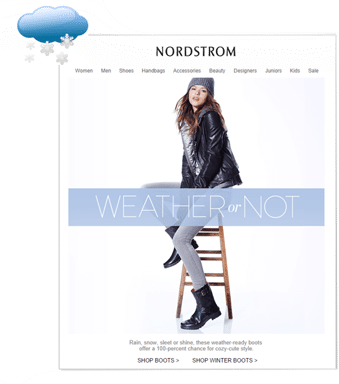
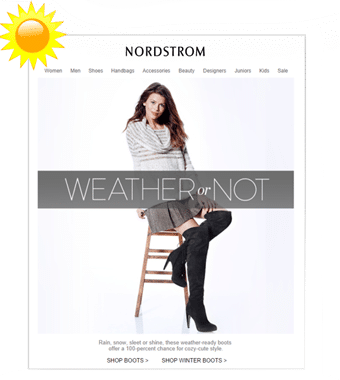
5. Your Blog Needs to Speak Up, Literally
Every tech giant is on the pursuit of placing their smart speaker range in your customer’s (and your) household. With the increased adoption of smart speakers (26.2% of all U.S. adults have access to a smart speaker), there is going to be a demand for voice-activated content. The other aspect of the increased possession of smart speakers is another outlet for people to hear a podcast. So, 2020 may also be the year of the podcast making a commercial return.
6. Messaging Apps to Increase Virality
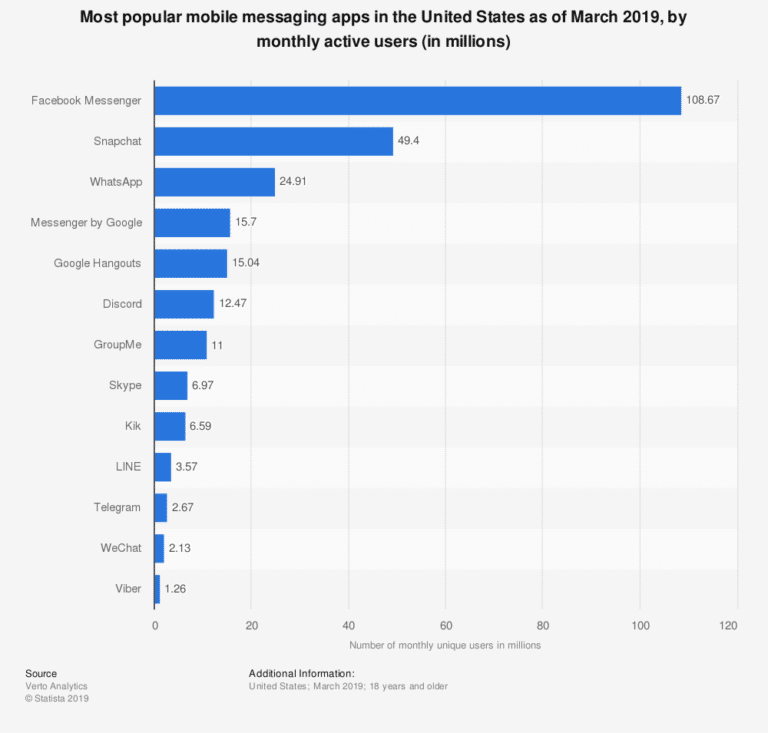
Image source: Statista
As evident from the above graph, users have their favorite messaging apps. People spend a considerable amount of time sharing emotions as well as valuable information using these popular apps. By crafting engaging content tailored for mobile app users, you increase the chances of making your content viral.
7. Reality Altering Content
While VR, as well as AR, may not be a newly-discovered concept, marketers are yet to tap into its potential. But there are speculations that by 2022, 3.5 billion mobile users worldwide will have adopted AR.
Marvel created AR stickers for Google Playground, wherein people can interact with characters from Avengers, for the promotions of their movie Avengers: Endgame.

Image source: XDA-developers
8. Content Marketing Budgets Are Increasing
Any form of marketing is bound by the budget you allocate, and content marketing is no different. In the case of content marketing, you need to set a balance between paid, owned, and earned. Thankfully, owing to increasing ROI, 57% of marketers aimed to increase their content marketing budget for 2019. It is safe to assume that in 2020, the number may now include those whose budget remained the same last year (29%).
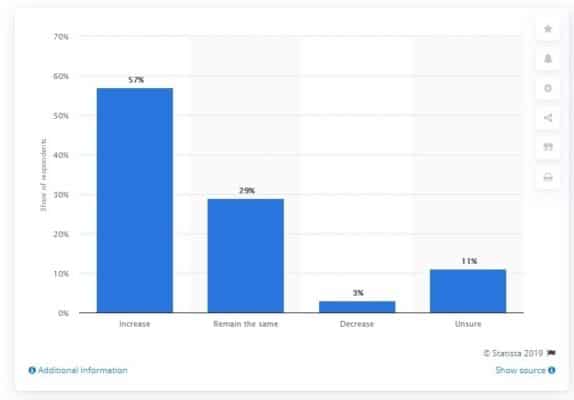
Image source: Statista
9. Increased Co-Branding Partnerships and Collaborations
Content exchange and co-branding are pivotal to expanding your audience base. With co-branding, the audience targeted might be the same, but the value addition from the increased downloads or engagement for each brand would be different. B2B brands have identified the advantages of co-branding, and 24% of B2B marketers have partnered with others to create engaging content.
10. Monologue AI Turns Conversational
Instead of having a one-sided interaction, your content marketing needs to converse with your customers. Whether it is over online chat or conducting Ask Me Anythings on social media platforms, people tend to have a good user experience when they talk to an actual human instead of chatbots. Since you cannot have an individual conversation with every customer, chatbots need to be provided a diverse library of content, customer data, and information that can be pulled when conversing with customers. Modern AIs are intelligent enough to sound human, provided you lay the proper groundwork with proper categorization and tagging of individual content.
11. Better Documentation of Content Marketing Strategies
We all know that a good strategy is essential for any marketing campaign. Not only do you list out different tasks involved but you also identify the key stakeholder responsible for the task completion. A documented content marketing strategy will help you track the progress of your content marketing efforts and measure the performance of each channel easily.
Ironically, only 37% of B2B brands and 38% of B2C brands have a documented content marketing strategy, while 36% have a content marketing strategy which is not documented. Luckily, 20% plan to have one within 12 months.
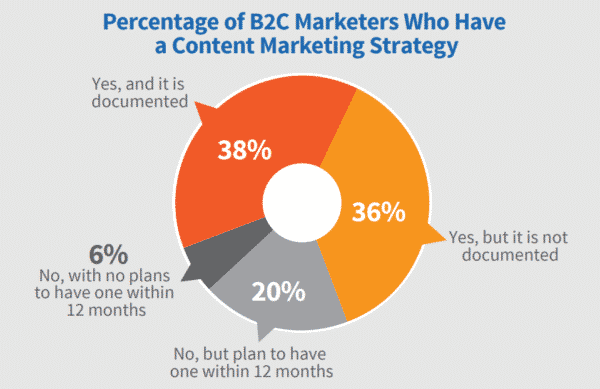
Image source: CMI
Content Marketing Tips and Tricks
1. Have Your Own Writing Style
Not everyone is a Shakespeare and that’s OK. It is good to consider some guidelines while writing, but don’t let that restrict you. Your content needs to have a brand personality and an individual voice, which can be a personification of your writing style.
2. Be Concise and Relevant
Readers may expect a quick-fix or at least a stopgap solution while interacting with your content, before making a purchasing decision. Irrespective of whether you use emails, blogs, infographics or even podcasts, don’t beat around the bush and get to the point quickly. Always ask the question, “How would this benefit my audience?” when creating content.
3. Be Open to Guest Posting
A content exchange will help you expand your audience range as well as give a fresh new feel to your existing blogs. Do not hesitate to promote your guest posts on social media for additional exposure and also ask others to share it. Guest posting can also be an good way to improve your SEO rankings.
4. Accept Feedback
Metrics can help you understand the engagement level of your readers, but you always need to get feedback to understand what they liked (and disliked). Periodically conduct surveys and polls to gauge the responses of your readers, and make corresponding changes to your content.
5. Repurpose Old Content
Any content you put up is not a lost cause if it doesn’t perform. Instead, the existing content is a slab of marble from which you can carve out your ‘David’ by repurposing the content. There may be a chance the content is informative, but the format is the bottleneck.
Convert your low-performing blog post into a visually attractive infographic or a video and observe any change in the engagement level of your customers.
6. Use Scheduling Tools to Make Life Easier
In the case of content marketing, it is crucial to stick to a publishing calendar. Since there are different types of content for different platforms, you need to make sure that the content is deployed at the right time. This doesn’t mean you need to schedule all your content manually. Use tools such as Hootsuite to schedule social media posts and ESPs to do the same for your email campaigns.
7. Never Clickbait
Clickbait content pieces are like cheap thrills; always short-lived. Content should build relationships, and any connection built from conning people will result in a fast decline. Use your content to build the trust of your readers with honest and straightforward copy.
Wrapping Up
Content marketing will reward you with engaged customers and long-lasting relationships but it will demand patience and skill in return. 2020 brings with it new content marketing opportunities, and we hope that this article has helped you navigate your options and craft your content marketing strategy for the year.
Have any upcoming trends to share? We would love to read your thoughts and suggestions in the comments below.
_
About the author: Annie Geller is a Brand Strategist (or as she likes to say, “email marketing handyman”) at QeInbox.
No comments:
Post a Comment